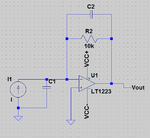eigenroot
Junior Member level 3

I have a circuit measuring the response of a photoreceiver as follows

The photoreceiver can be modeled as a current source and a shunt capacitor (I1 and C1). When I shine a square wave light pulse on the photoreceiver, The output Vout has obvious overshoot on the rising edge, and deep under shoot in the falling edge. But there is no oscillation after overshoot and undershoot.
I am trying to find whether the overshoot and undershoot are from the response of I1, or a result of circuit response (such as C1). Actually C1 is very large, above 1nF. C2 is small compared to C1.
So my question is: what can cause the overshoot (without oscillation) above, and how?

The photoreceiver can be modeled as a current source and a shunt capacitor (I1 and C1). When I shine a square wave light pulse on the photoreceiver, The output Vout has obvious overshoot on the rising edge, and deep under shoot in the falling edge. But there is no oscillation after overshoot and undershoot.
I am trying to find whether the overshoot and undershoot are from the response of I1, or a result of circuit response (such as C1). Actually C1 is very large, above 1nF. C2 is small compared to C1.
So my question is: what can cause the overshoot (without oscillation) above, and how?


